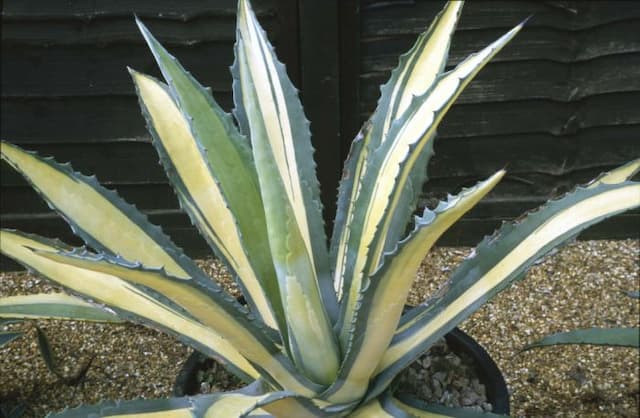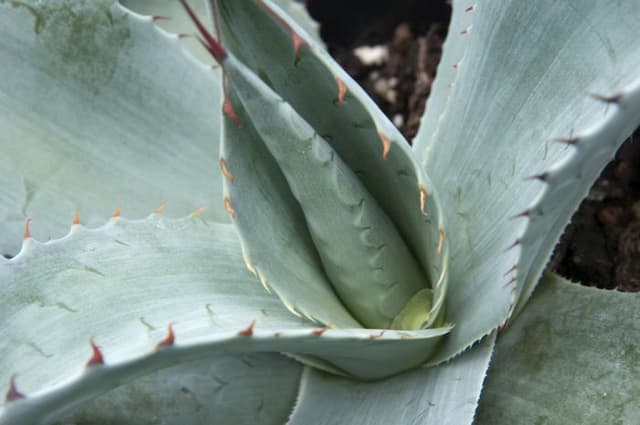Plantain Lily Hosta 'Stiletto' (v)

ABOUT
The Hosta 'Stiletto' is a perennial plant known for its distinctive foliage. It boasts narrow, elongated leaves that have a rippled texture, adding a sense of movement to its appearance. The leaves exhibit a bright green color with a glossy sheen that can catch the light, making it an attractive addition to any garden. The margins of the leaves are slightly wavy, which further accentuates the rippled effect. During the blooming period, the Hosta 'Stiletto' produces slender flower stalks that rise above the foliage, adorned with tubular flowers. The flowers can add a touch of subtle elegance to the plant’s overall look. This variety is appreciated for its ornamental leaves, which form a dense and lush mound, creating an eye-catching ground cover or border plant in shaded garden areas. The Hosta 'Stiletto' is hardy and versatile, making it a favored choice for gardeners looking to add texture and variegated green hues to their plant collections.
About this plant
 Names
NamesFamily
Asparagaceae
Synonyms
Plantain Lily, Funkia
Common names
Hosta lancifolia, Hosta ventricosa 'Stiletto', Hosta 'Stiletto'
 Toxicity
ToxicityTo humans
Hostas, including the variety 'Stiletto', are generally not considered toxic to humans. However, if ingested in large quantities, they could potentially cause an upset stomach or other digestive disturbances. Symptoms of poisoning are generally mild and can include nausea, vomiting, and diarrhea. While they are not typically dangerous, it is advisable to avoid consuming any part of the plant.
To pets
Hostas are known to be toxic to cats and dogs. If pets ingest any part of the plant, they can experience symptoms such as vomiting, diarrhea, and depression. In more severe cases, the ingestion can lead to more significant effects like excessive drooling and abdominal pain. It is essential to keep hostas, including the 'Stiletto' variety, out of reach of pets and to seek immediate veterinary care if you suspect your pet has eaten any part of the plant.
 Characteristics
CharacteristicsLife cycle
Perennials
Foliage type
Deciduous
Color of leaves
Variegated
Flower color
Lavender
Height
1 foot [30 cm]
Spread
1 foot 6 inches [45 cm]
Plant type
Herb
Hardiness zones
3
Native area
Asia
Benefits
 General Benefits
General Benefits- Low Maintenance: Hostas are generally easy to care for and Hosta 'Stiletto' is no exception, requiring minimal upkeep once established.
- Shade Tolerance: This variety thrives in shady areas where other plants might struggle, making it ideal for woodland gardens or north-facing yards.
- Versatile Landscaping: Hosta 'Stiletto' can be used in a variety of landscaping designs, including borders, ground covers, and container gardening.
- Drought Tolerance: Once established, it can tolerate periods of dryness, although it prefers consistently moist soil.
- Texture and Color: Its slender, pointed leaves add unique texture and a lush green color to garden spaces.
- Attracts Wildlife: The flowers of Hosta 'Stiletto' can attract hummingbirds and butterflies to your garden.
 Medical Properties
Medical PropertiesThis plant is not used for medical purposes.
 Air-purifying Qualities
Air-purifying QualitiesThis plant is not specifically known for air purifying qualities.
 Other Uses
Other Uses- Accent in Shade Gardens: Hostas are primarily used for ornamental purposes; 'Stiletto' can add unique texture and color contrasts to shadowy garden spots.
- Container Gardening: Due to its manageable size, Hosta 'Stiletto' can thrive in pots, making it a versatile choice for patios and balconies with limited space.
- Pathway Edging: The narrow, pointed leaves of Hosta 'Stiletto' can serve as natural low border along garden paths or walkways.
- Ground Cover: Hosta 'Stiletto' can be used as ground cover to fill in areas under trees where other plants may struggle to grow due to lack of sunlight.
- Foliage for Floral Arrangements: The distinctive leaves of the Hosta 'Stiletto' can be included in floral arrangements for their texture and longevity.
- Living Mulch: Planting Hosta 'Stiletto' densely can suppress weeds and retain soil moisture, acting as a living mulch under taller shrubs or trees.
- Creative Leaf Impressions: The leaves can be used to create impressions in various art projects, such as clay or cement stepping stones for a garden.
- Aquascaping: Hosta 'Stiletto' leaves can contribute a terrestrial element in semi-aquatic setups, although the plant itself is not aquatic.
- Photography Subject: Due to its striking foliage, Hosta 'Stiletto' is often used as a subject in garden photography to capture the beauty of shaded plant life.
- Education and Demonstration: Hostas can be used in educational settings, such as schools and botanical gardens, to teach about shade gardening and plant diversity.
Interesting Facts
 Feng Shui
Feng ShuiThe Hosta is not used in Feng Shui practice.
 Zodiac Sign Compitability
Zodiac Sign CompitabilityThe Hosta is not used in astrology practice.
 Plant Symbolism
Plant Symbolism- Resilience: Hostas, known for their hardiness, symbolize the ability to withstand or recover quickly from difficult conditions.
- Devotion: The perennial nature of hostas, which return each year, represents loyalty and steadfastness in relationships.
- Adaptability: Hostas can thrive in a range of climatic conditions and soil types, symbolizing the quality of being able to adjust to new conditions.
- Heartiness: Their lush foliage and ability to grow well in the shade make hostas a symbol of vigorous health and growth.
 Water
WaterHostas require consistent watering to keep the soil moist but not waterlogged. Water your Hosta 'Stiletto' deeply so that the water reaches the roots, approximately once a week, depending on the climate and weather conditions. A good rule of thumb is to provide about one gallon of water per square foot per week. During hot or dry periods, you may need to water more frequently, while in rainy seasons, you may need to water less. Avoid overhead watering to minimize leaf wetness and reduce the risk of fungal diseases.
 Light
LightHosta 'Stiletto' performs best in partial to full shade. Ensure it is planted in a spot that receives morning light and protection from the intense afternoon sun. These plants are ideal under the shade of trees or on the north side of buildings where they receive diffused light. Too much sunlight can scorch the leaves, whereas too little can reduce the vigor of the plant.
 Temperature
TemperatureHostas thrive in a wide temperature range and can tolerate a minimum temperature of about 30 degrees Fahrenheit, although growth slows significantly below 50 degrees Fahrenheit. Hosta 'Stiletto' grow best in temperatures between 70 and 85 degrees Fahrenheit. However, it's important to note that they are cold-tolerant and can survive winters in the ground to USDA Hardiness Zones 3 to 8.
 Pruning
PruningPrune Hosta 'Stiletto' to remove dead or damaged leaves throughout the growing season to maintain plant health and appearance. Complete a more thorough cleanup in late fall or early spring by removing spent foliage from the previous year to minimize disease risk. The best time for significant pruning is early spring before the leaves have fully unfurled.
 Cleaning
CleaningAs needed
 Soil
SoilThe best soil mix for Hosta 'Stiletto', commonly known as Plantain Lily, should be well-draining, rich in organic matter, and slightly acidic to neutral, with a pH of 6.0 to 7.0. A mixture incorporating peat moss, compost, and perlite or vermiculite will create an ideal environment for root growth and overall health.
 Repotting
RepottingHostas, including the Plantain Lily, typically do not require frequent repotting and can thrive in the same container for several years. Repotting every 3 to 5 years or when the plant outgrows its pot will suffice.
 Humidity & Misting
Humidity & MistingPlantain Lilys do well in average to high humidity conditions; aiming for about 50% relative humidity is beneficial for the plant's health, though they are generally tolerant of a range of humidity levels.
 Suitable locations
Suitable locationsIndoor
Keep in bright, indirect light and ensure soil is moist.
Outdoor
Plant in partial to full shade, and mulch to retain moisture.
Hardiness zone
3-9 USDA
 Life cycle
Life cycleHosta 'Stiletto', commonly known as 'Stiletto' Hosta, begins its life cycle as a dormant rhizome or as seeds. When conditions are favorable in early spring, the rhizome sprouts and develops into a small rosette of lance-shaped, ruffled leaves with wavy margins. Throughout the spring and into summer, the plant grows vigorously, its foliage expanding to form a dense, mounding clump. By mid to late summer, it produces tall flower scapes that bear lavender blooms, which are attractive to pollinators like bees and hummingbirds. After flowering, the plant sets seeds, which can be dispersed by wind or wildlife, contributing to the propagation of new plants. As temperatures drop in the fall, the foliage dies back, and the plant enters a period of dormancy during the winter, conserving energy in its rhizome until the next growing season.
 Propogation
PropogationPropogation time
Spring to Summer
The most popular method of propagating Hosta 'Stiletto', commonly known as plantain lily, is by division. The ideal time to propagate by division is in the early spring just as the plant begins to emerge and the new growth points, often referred to as "eyes," are visible yet not fully expanded. Carefully dig up the entire plant, maintaining as much of the root system as intact as possible. Using a sharp knife, spade, or even your hands, split the plant into smaller sections ensuring each section has at least two or three growth points. Each division can then be replanted in a prepared hole that is twice as wide as the root ball, spaced approximately 15 to 30 inches apart depending on the mature size of the variety. Water the newly planted divisions thoroughly to settle the soil around the roots and to help reduce transplant shock.



![Beschorneria [Flamingo Glow]](/_next/image?url=https%3A%2F%2Fplants-admin.emdemapps.com%2Fimages%2Fplants%2F%2Fimages%2F604b59df2e78d.png&w=640&q=75)




